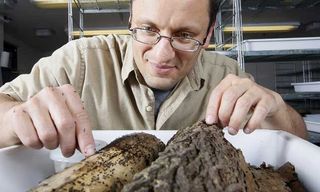Rural Ants Supersize When They Go Urban

The old story of a small-town kid making it in the big city has now been found in ants, a scientist revealed.
The ant species in question, the odorous house ant (Tapinoma sessile), may have evolved for life in some of the tightest spots in the forest, but once it moves into our comparatively roomy buildings and cities, its colonies explode in size, developing a whole new way of life.
These ants, also known as coconut ants, are normally quite inconspicuous, mostly living in hollow acorn and hickory nut shells in the forest and active only during warm times from spring to fall. They are dubbed 'odorous' and 'coconut' due to the coconut- or rum-like smell they release when crushed.
In the forest, these ants live about 50 to a colony with one queen. However, in semi-natural areas that are a cross of forest and urban spots, such as a park, urban entomologist Grzegorz Buczkowski at Purdue University observed ant colonies of about 500 workers with a single queen. As the ants get closer to urban areas, they likely prosper from easier access to food, shelter, warmth and other resources, as well as from the absence of competitors, he said.
Once they go fully urban, the ants can grow supercolonies, increasing in size thousands-fold to more than 6 million workers and 50,000 queen ants.
"They use walls and buildings almost like giant incubators where they can raise large broods," Buczkowski explained.
These insects are now considered one of the most common, dominant house ant pests.
Sign up for the Live Science daily newsletter now
Get the world’s most fascinating discoveries delivered straight to your inbox.
"In the forest, they have to compete for food and nesting sites," he said. "In the cities, they don't have that competition. People give them a place to nest, a place to eat."
Since the odorous house ants were able to create complex colonies, one might expect other ants to do the same. However, Buczkowski found no evidence that other ants evolved into larger groups as the odorous house ants have.
It remains a mystery as to why this species forms supercolonies while other native ants don't.
"In the forest, these ants not only compete with other species of ants, but with members of their own species — workers from different colonies are very aggressive toward each other," Buczkowski explained. "We don't really know yet how they get from single-queen colonies to multiple-queen colonies."
Understanding why the supercolonies form could lead to better control of the pests in homes, as well as ensure that they don't out-compete beneficial species.
"We want to take ants both from the forest to the city and from the city to the forest to learn more about their behavior," Buczkowski said.
Buczkowski detailed his findings in an early online edition of the journal Biological Invasions.
- Top 10 Amazing Animal Abilities
- What Is it Like to Be an Ant?
- Images: Ants of the World

Most Popular


